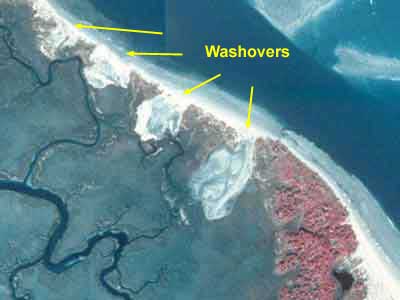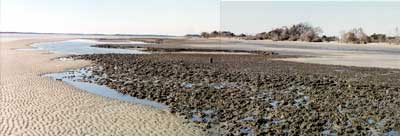 |
 |
.....Barrier
island are places of change and motion. Islands grow and shrink depending
on the amount of sediment available in the local system, and global conditions
like change in sea level. An island that is growing seaward is called
prograding barrier island, while one that is migrating toward the
mainland is termed retrograding.
.....In most cases an island that is retrograding
undergoes a process known as "island rollover". Island rollover
is common on islands with low profiles and few dune ridges. This process
also occurs on islands that experiencing erosion due to a stifled sediment
supply such as Folly Beach. Two major types of evidence that show an island
is rolling over are washovers and exposed marsh mud on the beach face.
.....Washovers occur when storm waves wash
over low lying sections of the beach removing sand from the beach face
and depositing it in the marsh behind the dunes. The image below shows
some washovers on the northern end of Folly Beach near Lighthouse Inlet. |
| |

(click on image for higher resolution) |
|
| .....Exposed
marsh mud on the beach face is more evidence that an island is rolling
over. As the dunes and beach face retreat toward the mainland, the marsh
behind is covered. As the island continues to retrograde, this buried
marsh become exposed on the beach face. This mud is made up of fine clays
and plant material making it very resistant to erosion by wave action.
Marsh mud on the beach is easy to find at low tide on Folly at both the
county park area and the northern end of the island. |

(click on images for higher resolution) |
 |
| |